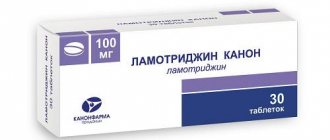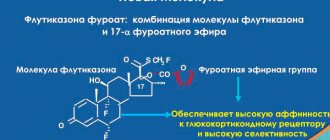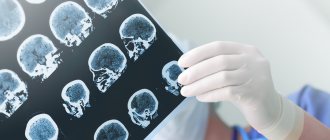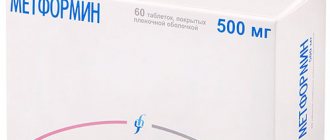Pharmacological properties of the drug No-shpa
Pharmacodynamics. Drotaverine is an isoquinoline derivative that has an antispasmodic effect on smooth muscles by inhibiting the action of the PDE IV enzyme, causing an increase in the concentration of cAMP and, due to the inactivation of myosin light chain kinase (MLCK), leads to relaxation of smooth muscles. In vitro, drotaverine inhibits the action of the PDE IV enzyme and does not affect the action of the PDE III and PDE V isoenzymes. PDE IV is of great functional importance for reducing the contractile activity of smooth muscles, therefore selective inhibitors of this enzyme may be useful for the treatment of diseases that are accompanied by motor hyperfunction, as well as various diseases during which gastrointestinal spasms occur. In the smooth muscle cells of the myocardium and blood vessels, cAMP is hydrolyzed to a greater extent by the PDE III isoenzyme, therefore drotaverine is an effective antispasmodic agent that does not have significant side effects on the cardiovascular system and a strong therapeutic effect on this system. Drotaverine is effective for smooth muscle spasms of both nervous and muscular origin. Drotaverine acts on the smooth muscles of the gastrointestinal, biliary, genitourinary and cardiovascular systems, regardless of the type of innervation. Increases blood circulation in tissues due to its ability to dilate blood vessels. The action of drotaverine is more effective than that of papaverine, absorption is faster and more complete, it binds less to blood plasma proteins. The advantage of drotaverine, in contrast to papaverine, is that after its parenteral administration there is no such side effect as stimulation of respiration. Pharmacokinetics. Drotaverine is quickly and completely absorbed after parenteral and oral administration. It binds to a high degree (95-98%) with blood plasma proteins, especially with albumin, gamma and beta globulins. After primary metabolism, 65% of the administered dose enters the blood circulation unchanged. Metabolized in the liver. The half-life is 8–10 hours. Within 72 hours, drotaverine is almost completely eliminated from the body, more than 50% is excreted in the urine and approximately 30% in feces. Drotaverine is mainly excreted in the form of metabolites and is not found in unchanged form in the urine.
Poisons are not a toy for adults
Admit it, each of us sometimes wanted to “die so that everyone would cry.” One of the most common ways to prove something to someone, take revenge and make them nervous is an attempt at poisoning. Alas, sad statistics show that dying from poison is not so easy. A much more likely prospect is to continue living on disability and regretting “what a fool I was.” So I warned you. And now I’ll tell you what to do with those who didn’t listen.
Juliet with no-shpa
One morning I was replacing a colleague. We stood in the smoking room, sharing the latest news.
“What, how did it go?” I asked, passively inhaling the aroma of nicotine tar. “It was a lousy shift,” a fellow resuscitator exhaled a portion of smoke sadly. - What's wrong? “I didn’t sleep half the night, they brought a knife to my stomach.” After the operation, while blood and plasma were infused, treatment was prescribed, it was already three nights. Lie down. Half an hour of rest and the call again - the receiver calls,” here he grinned slyly, “they brought a girl and a guy, she’s in snot and tears, the second one is pale, shaking. - What, love wasn’t shared? “Yeah, stupid,” she swallowed the pills. Blood pressure is normal, conscious... - Why come to us? “So I ask the short-lived people: “Why come to us?” Those: “well, like some kind of order, the young girl will suddenly die”...
They took me to the intensive care unit, I asked: “What did you swallow?”, she rubbed away her tears, sat pale: “I-I took five tablets of no-shpa and five charcoal.” "Yo Mama!" - I burst out. They were scared. Guy: “What, doctor, is everything so serious?” I told him: “It’s a complete mess! I don’t know how this could end!” The lady turned paler than ever and began to tremble. Guy: “Doctor, please save my girlfriend! It's my fault! Help!”...
It’s funny now, but then I was as angry as a dog: I pulled my gloves up to my elbows, found the thickest gastric tube, put on an apron, and screwed the tube into her as hard as possible. They managed to substitute a basin in time, the thin girl folded in half and vomited. The probe fell into the basin... I took out this dirty hose, all the liquid was draining from it. She told me with tears in her eyes: “A-are you going to shove this at me again?” “But of course!” – I grinned, wiped it with a rag and again forced the rubber snake to swallow.
- Well, you give it! – I laughed. - Well, what? There’s no point in playing suicide at night,” he grinned, putting out his cigarette.
"Weapons of Cowards and Women"
Since time immemorial, people have used plant extracts, the mucus of poisonous frogs, and chemical compounds to kill their enemies. Women dropped belladonna into their eyes “for the beauty of the eyes.” Men of the New World used curare poison to kill animals. Kings and courtiers poisoned each other with plant poisons. Opium was the drug of choice in the Middle East.
There have always been poisons. Some were transformed into medicines, others remained poisons. Time passes, but life turns out to be not so changeable, and we encounter poisons everywhere (acids, alkalis, cleaning products, varnishes, paints and much more).
As a resuscitator, this topic, on the one hand, is close to me, but on the other hand, it remains the dark side of the profession. Close - because the drugs we use are overwhelmingly potent and poisonous, and any mistake can cost the life of our patient.
The problem is that knowledge is sometimes powerless, especially when a patient admitted in a comatose state is not able to explain the cause of his condition. And it is not always possible to find out the type of poison “by eye”.
Although some symptoms scream about themselves. Let’s say there is an overdose of opiates: the patient breathes every once in a while, the mucous membranes are cyanotic, and most importantly, the pupils are narrow and pinpointed. Those poisoned by carbon monoxide are always pink, from altered hemoglobin, unable to carry oxygen. Fortunately, if relatives bring packages of medications, they will report inhalation of toxic fumes. But all this is rare.
In the vast majority of cases, we work by touch. Of course, we take tests of gastric contents, blood, urine, but when will these tests be ready? A week later! And even later. And the patient must be saved now!
Often the poison, like the Moor, has done its job and left, triggering a set of reactions leading to multiple organ failure. And we are not “Doctor Houses”; we do not have the opportunity or time to crawl through apartments and examine the contents of cellars. Therefore, I’m not going to fill your heads with secret antidotes, I’ll just tell you about the basics of detoxification.
In general, now I’ll tell you in detail what to do when someone accidentally or not very well, in everyday life, swallowed or sniffed, or spilled some nasty stuff on themselves. About what you can do at home without harming the health of the victim.
While the ambulance is on the way
Poisoning with acids and alkalis.
I combined them as cauterizing poisons. Yes, alkalis cause liquefaction necrosis, and acids cause coagulation necrosis, causing more superficial tissue damage. But let the professionals understand these subtleties.
It is important for you: if this is a skin lesion, you need to rinse the affected surfaces with a stream of plain clean water and consult a doctor. If you take poison internally, drink water. Not soda, not acid, but ordinary water!
Under no circumstances should soda be used for acetic acid poisoning, although in chemistry lessons we conducted experiments on neutralizing acids with alkalis. And all because all reactions proceed with the release of a large amount of heat.
Do not induce vomiting, as burns can spread to the respiratory tract and vomiting can injure the mucous membranes and cause bleeding. You can drink Almagel, or Novocaine. But be sure to call an ambulance as soon as possible!
I don’t know what motivates suicidal people when they drink vinegar essence, but the fact that they are dooming themselves to torment is one hundred percent. And it is far from certain that death will occur. But the fact is that there will be wild pains that cannot be controlled by drugs, there will be a narrowing of the esophagus, there will be bougienage, there will be feeding through a hole in the stomach if the expansion of the esophagus does not help. Very often, cancer grows at the site of the altered esophagus...
In general, I repeat, to save the sufferer, use just water and no chemicals.
A small lyrical digression.
The further science goes, the easier it is to treat. Back at the beginning of this century, when liquid starches appeared, we literally prayed for them. The head of the department took this miracle drug out of the safe, and we fell on our faces. They pulled a match to see who would get this life-giving moisture today, who would come out of the coma today. And then the whole crowd walked and contemplated how the moisture sparkling in the morning dawn poured in drop by drop. Drip-drip-drip... We stood and watched and... nothing happened.
Moreover, as it turned out, this starch preparation is not without side effects and we are now using it strictly according to indications. Resistance to antibacterial drugs of the latest generations is still developing. All cerebroprotectors turned out to be ineffective. But the water... the water remained. Salty, sweet, it became the basis of our resuscitation care.
So don't make things up! Treat with water! And we, with our clinical and pharmacological knowledge, will... also treat with water, and something else.
Poisoning with pills.
Here, as much as possible, you need to find out what you took, when you took it, the total dose, in order to inform the doctor as accurately as possible. If you see a victim, he feels bad, there are tubes of pills nearby - call an ambulance!
If the patient is conscious
, simply trigger the gag reflex by irritating the back wall of the throat. Let him drink water - and he will vomit again. Gastric lavage is one of the main methods of detoxification. Even if a lot of time has passed and the poison has been absorbed, by washing the stomach, removing gastric contents along with the released toxin, even in such a household way, you will reduce the total concentration of the drug in the body. After gastric lavage, you can force him to take banal charcoal tablets.
If a person loses consciousness
, then, on the contrary, do not induce vomiting under any circumstances! In this state, protective reflexes are impaired, and all this nasty stuff can fly into the lung, aggravating the situation. In this case, we, resuscitators, first insert a tube into the trachea, protect the airways, and only then rinse the stomach with water.
Methyl alcohol, ethylene glycol or brake fluid
. It's more difficult with them. The fact is that they, in fact, are not poisonous, but as a result of the so-called “lethal synthesis”, thanks to the enzyme - alcohol dehydrogenase, toxic substances are formed. Formaldehyde and formic acid are formed from methanol. They are extremely toxic, 100 ml is considered lethal! The central nervous system and retina of the eye are affected, causing blindness.
Ethylene glycol breaks down to glycolaldehyde, glyoxal and oxaloacetic acid. These substances primarily affect the brain and kidneys.
Why did I dwell on metabolism in such detail? Yes, because for these poisonings you can prescribe an antidote. This antidote is ethyl alcohol, drinking alcohol or just good vodka. It is high-quality alcohol that will competitively bind to alcohol dehydrogenase and prevent lethal metabolism. Make him drink a glass of vodka before the ambulance arrives. Of course, if the patient is conscious.
If the victim is in a coma, that is, you cannot wake him up, he does not open his eyes, and is not available for contact - under no circumstances induce vomiting! Don't force him to drink anything. Just turn on your side, thereby making breathing easier and preventing vomit from entering the trachea.
Carbon monoxide poisoning
. And in general any gases. Be sure to pull the victim away from the source of poisoning and give him the opportunity to breathe fresh air. And be sure to call an ambulance!
Opiate poisoning
. I have already mentioned these substances. Symptoms: the patient does not breathe or breathes shallowly, the mucous membranes are bluish. Take a breath for him. It's simple: tilt your head back, open your mouth slightly, put on a scarf, pinch your nose, take a deep breath and exhale into the victim. You should see how the chest rises and he passively exhales and inhales again.
Call an ambulance! Emergency doctors have an antidote - naloxone, and there are means for artificial ventilation of the lungs. Until the ambulance arrives, you will have to breathe for him on your own. You can try to stir him up, rub his ears - he’s not waking up, he’s not breathing? Keep breathing yourself.
And once again I ask - do not invent a bicycle, do not remember the school chemistry course! Let the professionals handle the antidotes. "DO NO HARM!" – should be your and our motto.
Appreciate life, it is beautiful! Time smooths out a lot and changes a lot. Don't do things that you or your family will regret... Be healthy!
Vladimir Shpinev
Photo thinkstockphotos.com
Indications for use of the drug No-shpa
Pills. For therapeutic purposes in adults and children over 1 year of age with:
- spasms of smooth muscles associated with diseases of the biliary tract: cholecystolithiasis, cholangiolithiasis, cholecystitis, pericholecystitis, cholangitis, papillitis;
- spasms of smooth muscles in diseases of the urinary tract: nephrolithiasis, urethorolithiasis, pyelitis, cystitis, bladder tenesmus.
As an auxiliary treatment for:
- spasms of smooth muscles of the gastrointestinal tract: gastric and duodenal ulcers, gastritis, cardio- and/or pylorospasm, enteritis, colitis, spastic colitis with constipation and irritable bowel syndrome accompanied by flatulence; tension headache;
- gynecological diseases (dysmenorrhea).
Solution for injections . Spasms of smooth muscles associated with diseases of the biliary tract: cholecystolithiasis, cholangiolithiasis, cholecystitis, pericholecystitis, cholangitis, papillitis. Spasms of smooth muscles in diseases of the urinary tract: nephrolithiasis, urethorolithiasis, pyelitis, cystitis, bladder tenesmus. During uncomplicated labor at the dilatation stage: to reduce the cervical dilatation phase and the duration of labor. As an auxiliary treatment (when the use of the drug in tablet form is not possible): for spasms of smooth muscles of the gastrointestinal tract: stomach and duodenal ulcers, gastritis, cardio- and/or pylorospasm, enteritis, colitis; for gynecological diseases: dysmenorrhea, severe labor pains.
Performance Evaluation Method
If the patient can easily self-diagnose his condition and the symptoms of the disease are already familiar to him, then treatment can be effective without seeing a doctor. When, after several hours after taking the drug at its maximum single dose, there is a slight decrease in pain or a complete lack of pain relief, or if the pain does not decrease significantly and this causes you unnecessary discomfort, then you must consult a doctor.
Use of the drug No-shpa
Pills . Adults : The usual average dose is 120–240 mg per day in 2–3 divided doses. Children aged 1–6 years : the usual average dose is 40–120 mg per day in 2–3 divided doses. Children over 6 years of age : the usual average dose is 80–200 mg per day in 2–5 divided doses. Solution for injection : the usual average daily dose for adults is 40–240 mg (in 1–3 separate administrations) IM. For attacks of renal or hepatic colic - 40–80 mg IV slowly. To reduce the dilatation phase of the cervix during uncomplicated labor at the beginning of the dilatation stage - 40 mg IM. If this dose is ineffective, another 40 mg of No-Shpa is administered at intervals of 2 hours.
Side effects of the drug No-shpa
Side effects observed in clinical studies and caused by taking drotaverine are classified by organs and systems, as well as by frequency of occurrence: very often (≥1/10), often (≥1/100, but ≤1/10), infrequently (≥ 1/1000, but ≤1/100), rare (≥1/10,000, but ≤1/1000), very rare (≤1/10,000), including isolated cases. Gastrointestinal disorders: rarely - nausea, constipation. From the nervous system: rarely - headache, dizziness, insomnia. From the cardiovascular system: rarely - tachycardia, arterial hypotension. From the immune system: isolated: allergic reactions, especially in patients with hypersensitivity to metabisulfite.
Special instructions for the use of the drug No-shpa
Each tablet of No-Shpa contains 52 mg of lactose. When used according to recommended doses, up to 156 mg of lactose can enter the body at one time, which can cause gastrointestinal complaints in patients with lactose intolerance. Do not use for the treatment of patients with congenital lactase deficiency, galactosemia or glucose-galactose malabsorption syndrome. Use with caution to treat children, since no studies have been conducted on the effect of drotaverine on children. Use with caution in case of hypotension. Due to the risk of collapse during intravenous administration of the drug No-Shpa, the patient should be in a supine position. The drug contains metabisulfite, which may cause allergic-type reactions, including symptoms of anaphylactic shock and bronchospasm, especially in patients with a history of asthma or allergies. In case of hypersensitivity to sodium metabisulfite, parenteral administration of the drug should be avoided. You need to be careful when administering the drug parenterally to women during pregnancy. Use during pregnancy and lactation. As shown by the results of retrospective clinical studies, oral administration of the drug did not have a teratogenic or embryotoxic effect. However, caution should be exercised when prescribing the drug to women during pregnancy. Due to the lack of relevant research data, administration of the drug during breastfeeding is not recommended. Impact on the ability to drive a car and perform work that requires increased attention. If patients experience dizziness after using the drug, they should avoid potentially hazardous activities. It is necessary to warn patients that after parenteral, especially intravenous administration of the drug, it is recommended to refrain from driving and performing work that requires increased attention.
Is no-spa harmful for use during pregnancy?
Most pregnant girls ask a similar question. Does taking No-Spa harm the baby? After some research and experiments, it turned out that “No-spa” during pregnancy did not give any negative effect that would affect the health or development of the child. During the research, some pregnant women even noted an improvement in their well-being and a decrease in abdominal pain. Therefore, the drug will not harm the child unless its dose is exceeded.






